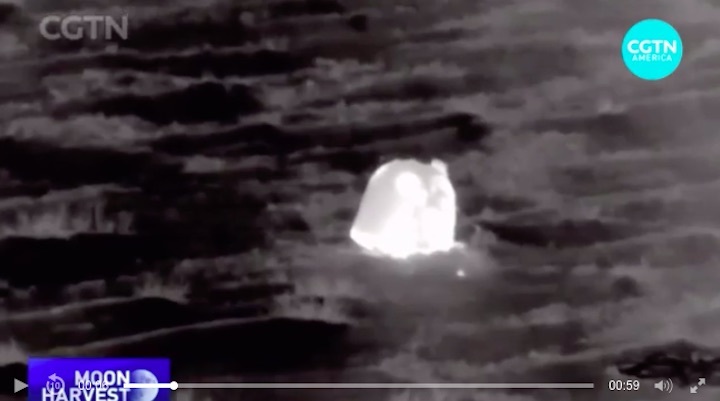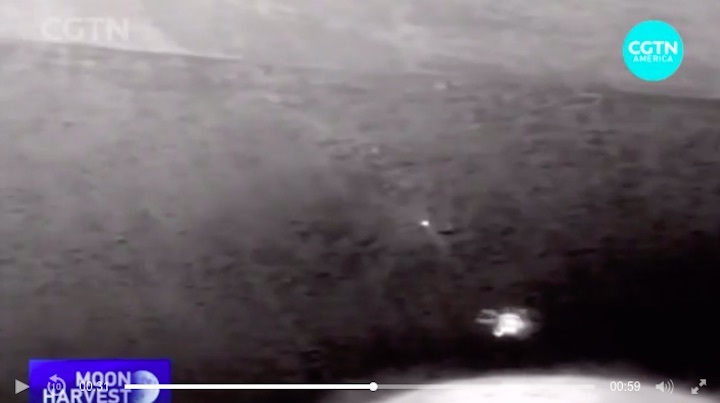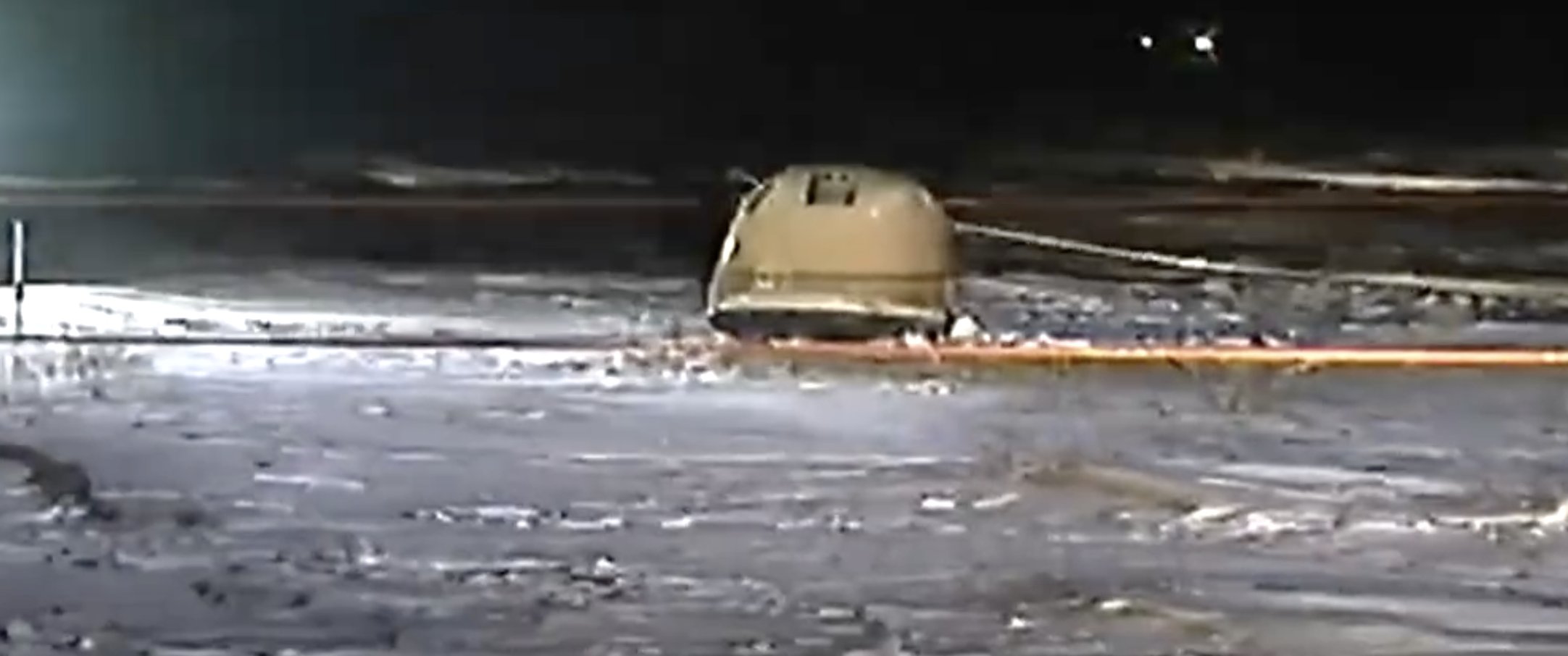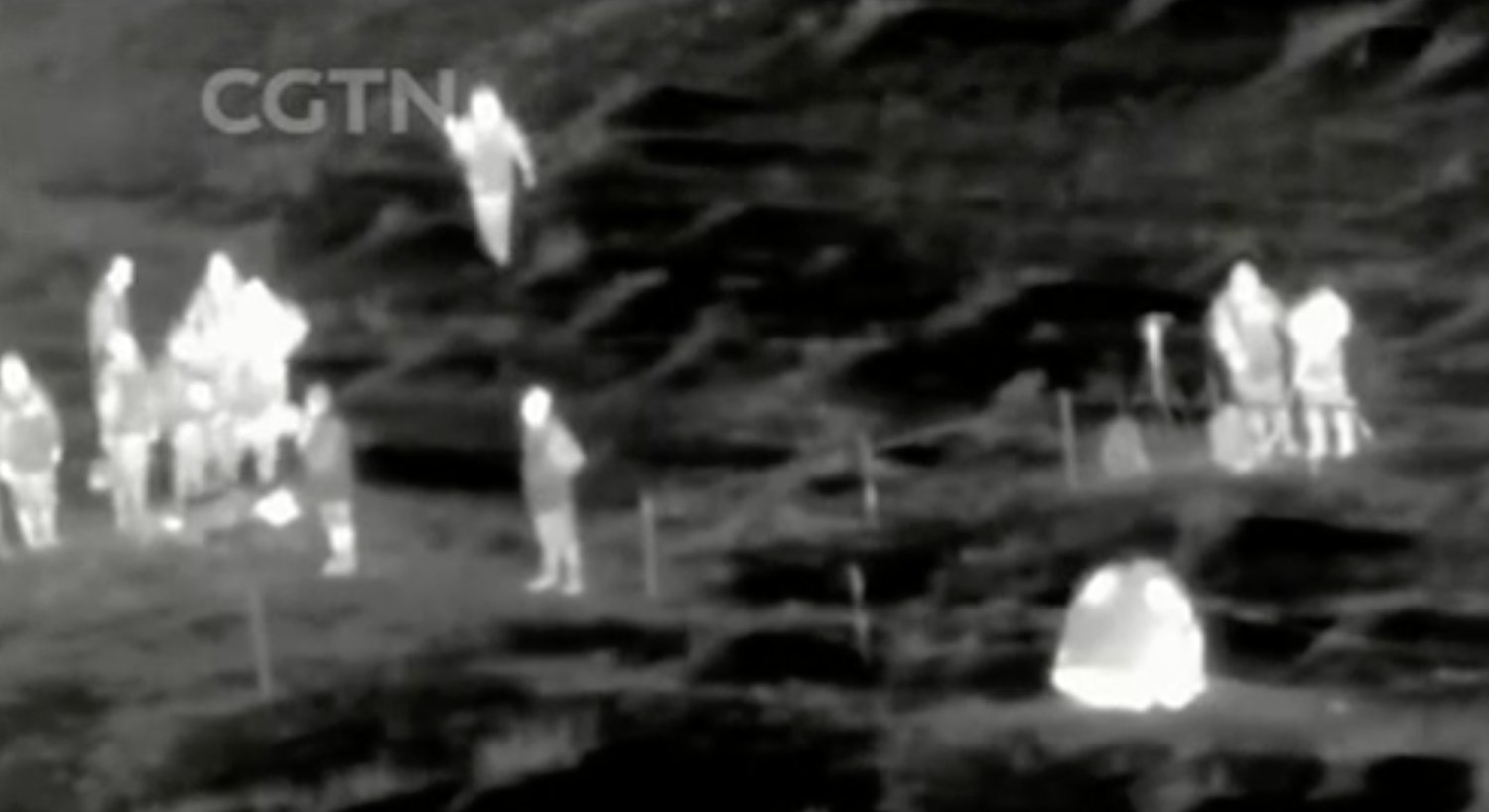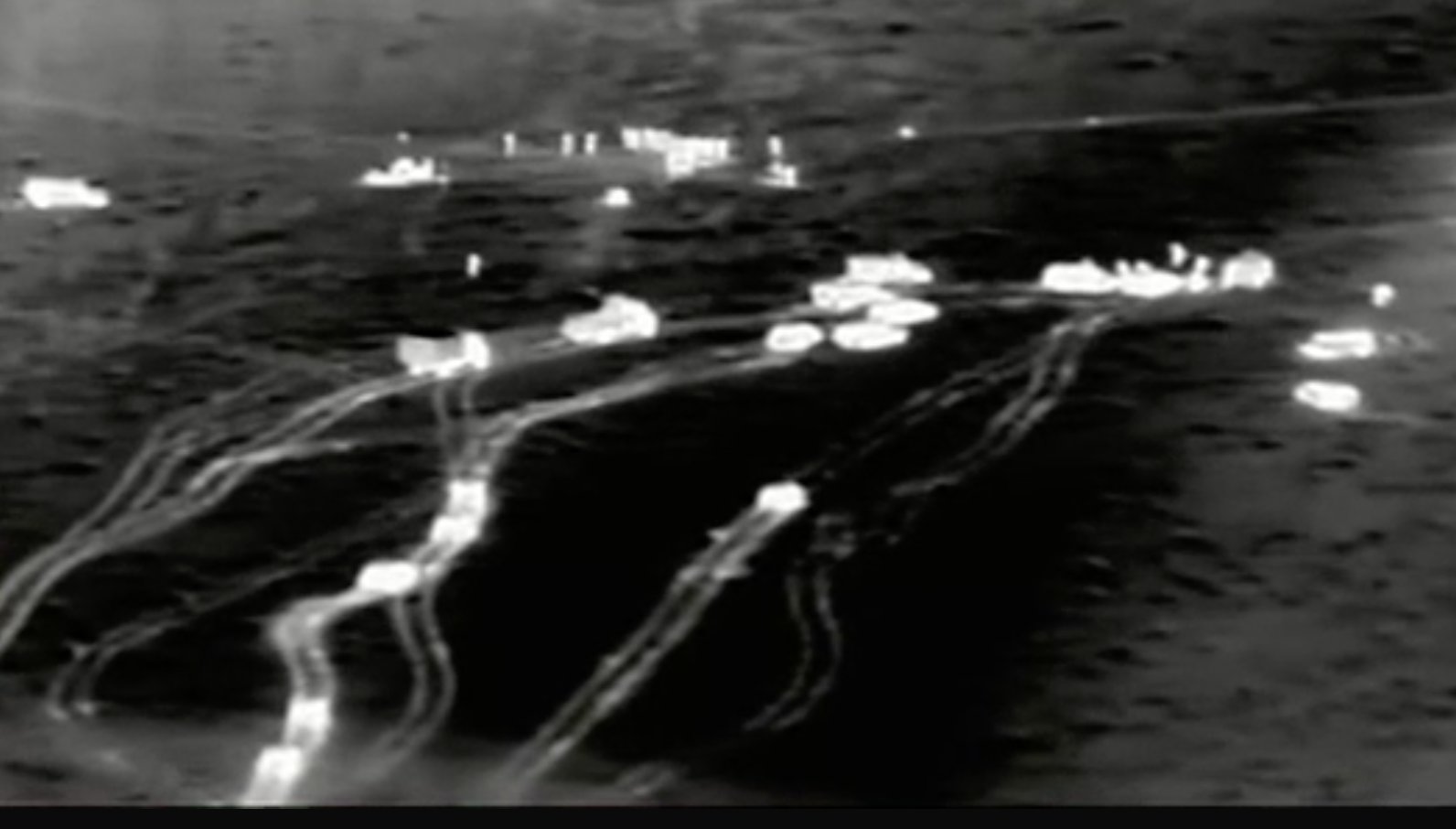9.12.2020
NASA's spacecraft spots China's Chang'e 5 lander on the moon
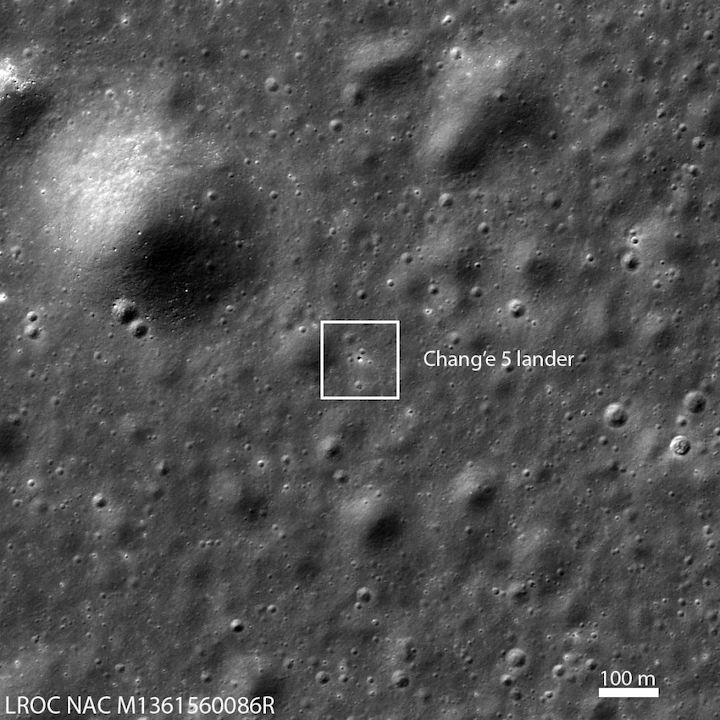
NASA's Lunar Reconnaissance Orbiter captured an image of China's Chang'e 5 lander on the moon just hours after its historic landing.
The Chang'e 5 lander set down on the lunar surface last Tuesday, Dec. 1. Thanks to China's prompt release of the stunning Chang'e 5 landing video, the Lunar Reconnaissance Orbiter Camera (LROC) team were able to locate the roughly 4-ton spacecraft in Oceanus Procellarum, the "Ocean of Storms," and prepare for when LRO would pass overhead the next day.
The image shows the Chang'e 5 lander in the center of three craters. Automated systems had helped the spacecraft avoid these hazards to land safely.
The relatively flat area near the Chang'e 5 lander was created by basaltic lavas. While over a billion years old, this unit of basalt is thought to be much younger than the Apollo landing areas, which are aged at over 3 billion years. Samples are therefore of great interest to scientists, who want to know why this region was volcanically active much more recently than most other places on the moon.
The image was taken before the Chang'e 5 ascent vehicle blasted off from the surface with the collected samples. The ascent vehicle has since performed aspectacular rendezvous and docking with the Chang'e 5 orbiter and handed over the samples. Chang'e 5 will begin its journey to Earth later this week.
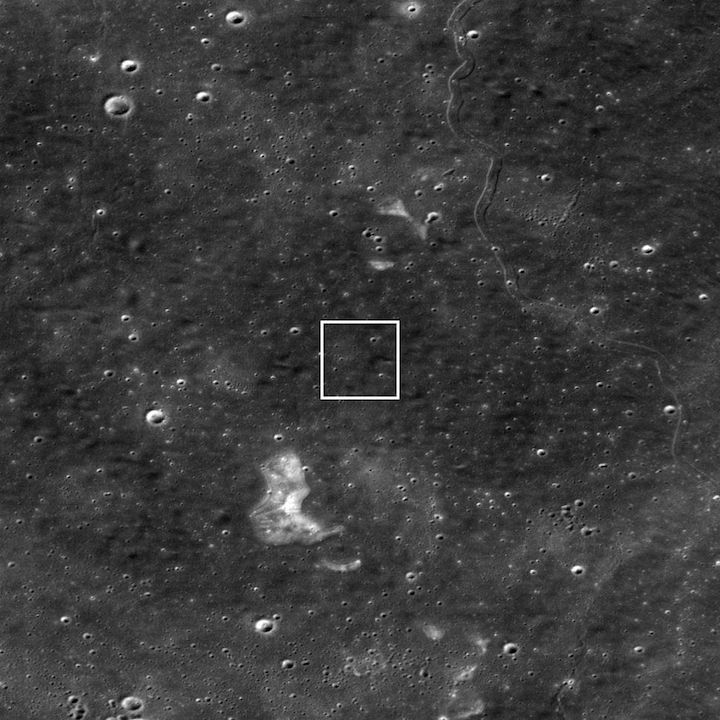
A wider view of the Chang'e 5 landing area taken by LRO. (Image credit: NASA/GSFC/Arizona State University)
The Chang'e 5 sample return mission is expected to last just 23 days, ending with a landing in Inner Mongolia around Dec. 17.
LRO meanwhile has been mapping the moon in high definition for more than 11 years while also hunting for signs of water.
Quelle: SC
+++
Chang'e 5 set to start journey to Earth
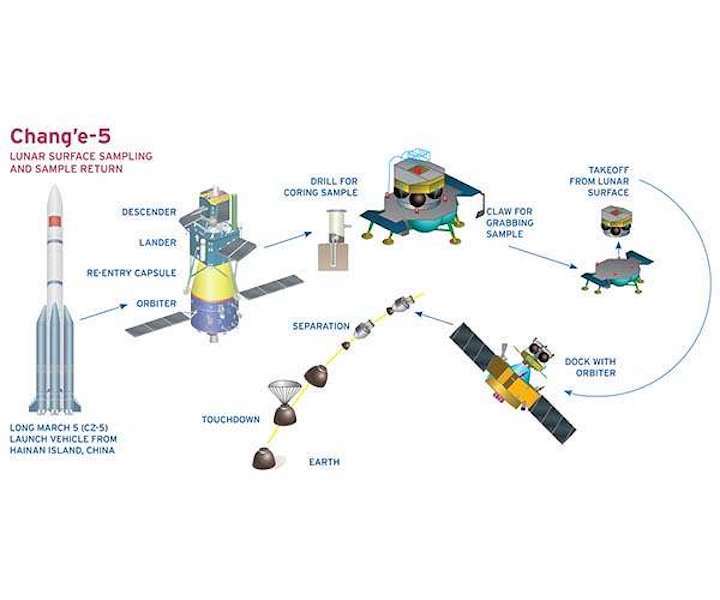
Lunar samples collected by China's Chang'e 5 robotic probe will soon start their journey toward Earth, according to the China National Space Administration.
The rocks and dust from the moon have been delivered from Chang'e 5's ascender to their final host-the probe's reentry capsule, which will later bring them to Earth.
The 400-kilogram ascender docked with the 2.3-metric ton orbiter-reentry capsule combination early on Sunday morning and then transferred a sealed container holding 2 kilograms of lunar samples into the capsule.
The operation was the first automated rendezvous and docking of any spacecraft in lunar orbit.
The last time two components of a spacecraft docked with each other in lunar orbit was in December 1972 during the final Apollo mission, and that was monitored and controlled by astronauts.
One of the most crucial devices during the highly sophisticated docking maneuver on Sunday morning, a microwave radar, which is mounted on the orbiter, worked with its transponder on the ascender to measure the rapidly changing distance and provided communication between the two traveling vehicles to allow them to adjust their position during the docking.
Engineers at the 25th Institute of China Aerospace Science and Industry Corp Second Academy designed and built the devices. They applied multiple advanced technologies to the apparatus, making them the best of their kind in the world, said Sun Wu, the equipment's chief designer at the institute.
Several hours after the docking, the ascender departed from the orbiter-reentry capsule combination around noon, while the combination continued orbiting the moon before its journey back to Earth, the space administration said in a statement on Sunday afternoon.
After arriving in Earth orbit, the pair will separate in due course, and the reentry capsule will conduct a series of complicated maneuvers to return to a preset landing site in North China's Inner Mongolia autonomous region in mid-December.
Chang'e 5, China's largest and most sophisticated lunar probe, has four main components-an orbiter, lander, ascender and reentry capsule. The spacecraft was launched by a Long March 5 heavy-lift carrier rocket on Nov 24 at the Wenchang Space Launch Center in Hainan province, setting out on China's most challenging lunar adventure and the world's first mission since 1976 to bring lunar samples to Earth.
The probe separated into two parts-the orbiter-reentry capsule combination and the lander-ascender combination-while in lunar orbit on Nov 30.
Late on Tuesday, the lander-ascender combination landed on the moon, becoming the world's third spacecraft to touch down on the lunar surface this century after its predecessors-Chang'e 3 and 4.Shortly after the landing, it began to use a drill to obtain samples from 2 meters beneath the lunar surface.
It finished the underground operation on Wednesday morning, and then started to use a mechanical arm to recover surface dirt.
All collection and packing processes were completed on Wednesday night, much sooner than expected. Samples were packed into a vacuum container inside the ascender.
The ascender activated an engine on Thursday night to lift itself into an elliptical lunar orbit to prepare for docking with the reentry capsule, marking the first time a Chinese spacecraft has blasted off from an extraterrestrial body.
If this mission is successful, it will make China the third nation to bring samples back from the moon, after the United States and the former Soviet Union.
A total of about 382 kilograms of lunar rocks and dust were recovered by the US Apollo mission astronauts and the Soviet Luna robotic landers from 1969 to 1976.
Quelle: SD
----
Update: 13.12.2020
.
Chang'e-5 orbiter-returner completes orbital maneuver to prepare for return
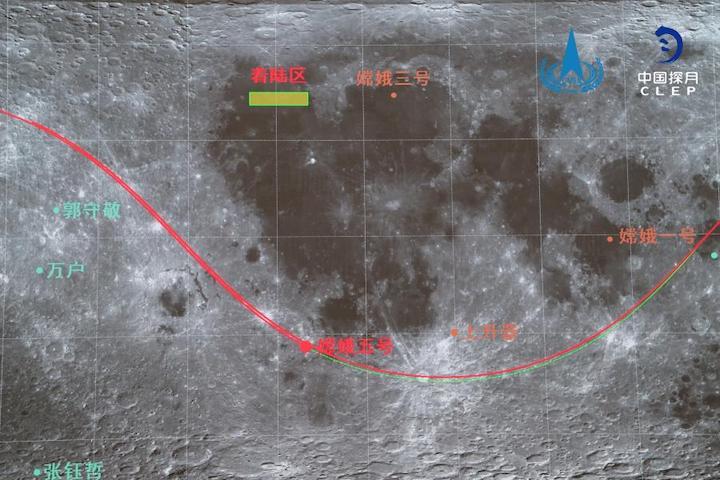
Track of subsatellite point of Chang'e 5 probe is seen through the monitor at Beijing Aerospace Control Center in Beijing, capital of China, Dec. 12, 2020. The orbiter-returner combination of China's Chang'e-5 probe on Saturday completed an orbital maneuver, preparing to leave the lunar orbit for a trajectory that returns it to Earth, according to the China National Space Administration (CNSA). After about six days in lunar orbit, the orbiter-returner combination completed the maneuver at 9:54 a.m. (Beijing Time), changing from a nearly circular orbit to an elliptical orbit with a perilune altitude of 200 km. (CNSA/Handout via Xinhua)
The orbiter-returner combination of China's Chang'e-5 probe on Saturday completed an orbital maneuver, preparing to leave the lunar orbit for a trajectory that returns it to Earth, according to the China National Space Administration.
After about six days in lunar orbit, the orbiter-returner combination completed the maneuver at 9:54 a.m. (Beijing Time), changing from a nearly circular orbit to an elliptical orbit with a perilune altitude of 200 km.
The orbiter-returner combination is scheduled to have another orbital maneuver to escape lunar gravity and enter the moon-Earth transfer orbit to return to Earth.
Chang'e-5 is one of the most complicated and challenging missions in China's aerospace history. It is also the world's first moon-sample mission in more than 40 years.
The probe, comprising an orbiter, a lander, an ascender and a returner, was launched on Nov. 24, and its lander-ascender combination touched down on the north of the Mons Rumker in Oceanus Procellarum, also known as the Ocean of Storms, on the near side of the moon on Dec. 1.
The probe's returner is expected to land at the Siziwang Banner in north China's Inner Mongolia Autonomous Region in mid-December. Enditem
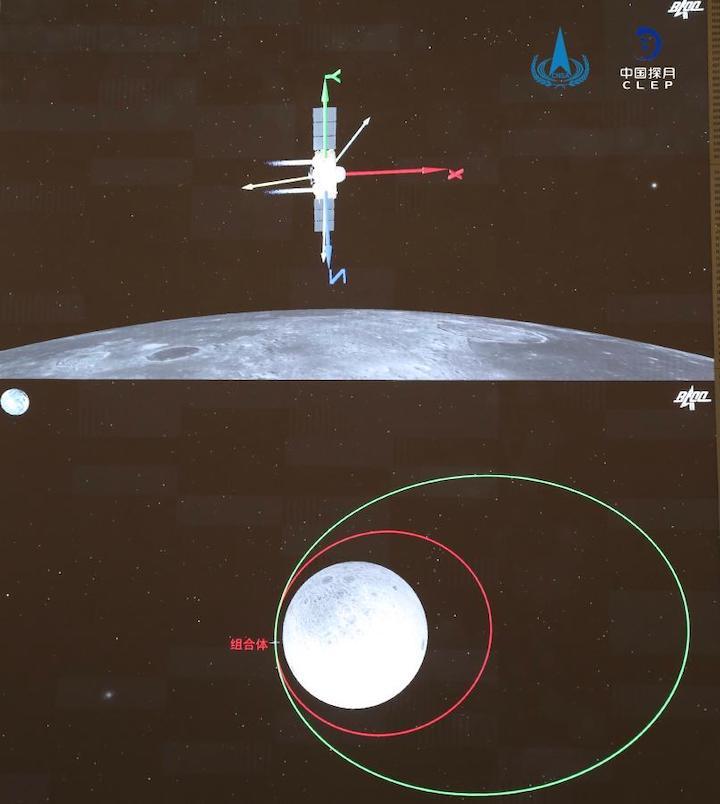
A simulated orbital maneuver is seen through the monitor at Beijing Aerospace Control Center in Beijing, capital of China, Dec. 12, 2020. The orbiter-returner combination of China's Chang'e-5 probe on Saturday completed an orbital maneuver, preparing to leave the lunar orbit for a trajectory that returns it to Earth, according to the China National Space Administration (CNSA). After about six days in lunar orbit, the orbiter-returner combination completed the maneuver at 9:54 a.m. (Beijing Time), changing from a nearly circular orbit to an elliptical orbit with a perilune altitude of 200 km. (CNSA/Handout via Xinhua)
Quelle: Xinhua
----
Update: 14.12.2020
.
Chang'e-5 orbiter-returner enters moon-Earth transfer orbit
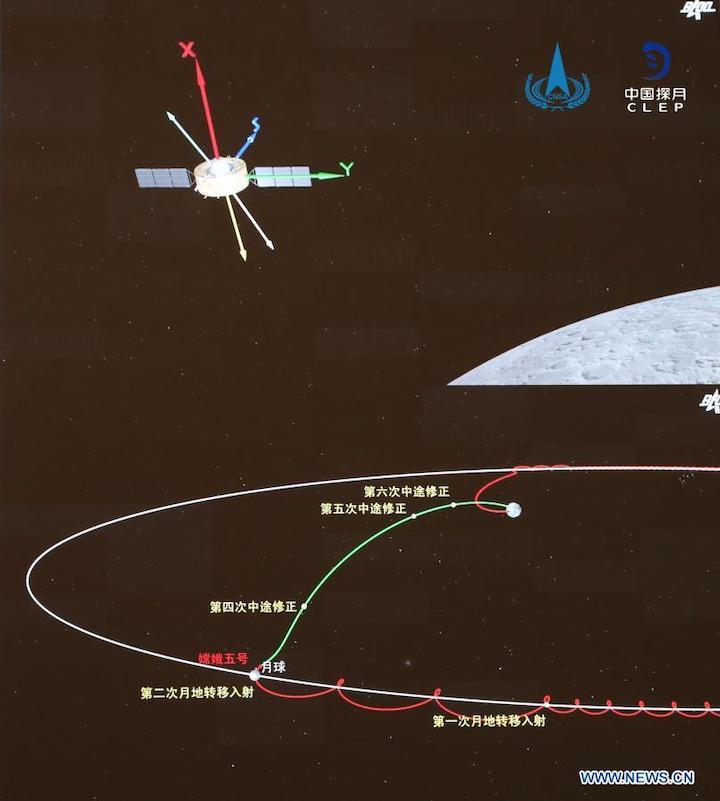
This simulated image shows the second orbital maneuver and orbital correction of the orbiter-returner combination of China's Chang'e-5 lunar probe. The orbiter-returner combination of China's Chang'e-5 lunar probe on Sunday completed the second orbital maneuver and entered the moon-Earth transfer orbit, sources with the China National Space Administration(CNSA) said. (CNSA/Handout via Xinhua)
The orbiter-returner combination of China's Chang'e-5 lunar probe conducted its second orbital maneuver at 9:51 a.m. on Sunday and entered the moon-Earth transfer orbit, sources with the China National Space Administration said.
Four 150N engines on the orbiter-returner combination ignited when they were 230 km away from the lunar surface and shut down after 22 minutes, the administration said in a statement.
According to real-time monitoring data, the orbiter-returner combination entered the targeted orbit successfully.
Later, the spacecraft combination carrying lunar samples will conduct orbital correction during its journey to Earth. When the time is right, the orbiter and returner will separate from one another, according to the administration.
The Chang'e-5, comprising an orbiter, a lander, an ascender and a returner, was launched on Nov. 24. Its orbiter-returner combination completed its first orbital maneuver on Saturday. Enditem
Chang'e-5 completes first orbital correction en route to Earth
China's Chang'e-5 probe on Monday completed its first orbital correction en route to Earth, according to the China National Space Administration (CNSA).
The orbital correction was conducted at 11:13 a.m. (Beijing Time) when the two 25N engines on the orbiter-returner combination were operational for about 28 seconds.
The CNSA said all systems on the orbiter-returner combination that carries lunar samples are currently in good condition.
The orbiter-returner combination entered the moon-Earth transfer orbit on Sunday.
When the time is right, the orbiter and returner will separate from one another, according to the CNSA. The probe's returner is expected to land at the Siziwang Banner in north China's Inner Mongolia Autonomous Region in mid-December.
Chang'e-5 is one of the most complicated and challenging missions in China's aerospace history. It is also the world's first moon-sample mission in more than 40 years.
The probe, comprising an orbiter, a lander, an ascender and a returner, was launched on Nov. 24, and its lander-ascender combination touched down on the north of the Mons Rumker in Oceanus Procellarum, also known as the Ocean of Storms, on the near side of the moon on Dec. 1. Enditem
Quelle: Xinhua
+++
China's space-tracking ship back from monitoring missions
China's space-tracking ship Yuanwang-5 returned to port Monday after completing three monitoring missions in the Pacific Ocean.
The ship, which returned to a port in east China's Jiangsu Province, operated for 82 days at sea, sailing over 18,000 nautical miles. During the voyage, it carried out maritime monitoring of the Chang'e-5 mission along with Yuanwang-6, another space-tracking ship.
Yuanwang-5 has operated at sea for 223 days in 2020, with total voyage measuring over 510,000 nautical miles.
After docking at the port, crew members will rest, examine the facilities and replenish supplies for upcoming missions. Enditem
Quelle: Xinhua
----
Update: 16.12.2020
.
North China readies for homecoming of Chang'e-5's capsule
As the Chang'e-5 probe will bring moon samples back to Earth, its preset landing site in Siziwang Banner in north China's Inner Mongolia Autonomous Region is ready for its return, according to the search and retrieval team of the mission on Tuesday.
To meet the challenges brought by harsh weather, heavy snow, the small size of the return capsule and the special returning method, the search and retrieval team in the landing site has conducted several drills to test its night-time searching abilities and equipment performance.
The return capsule of Chang'e-5 probe is only one-seventh the size of the return capsule of China's manned spaceship, however, its landing area is 16 times larger, adding difficulties to the search mission.
According to Bian Hancheng from the search team, the probe on the Chang'e-5 return capsule will adopt a skip reentry method mimicking a skipping stone, which will make it difficult to control and result in a particularly large retrieval area.
The search team has taken many technical measures to face those challenges. The processed radar data will be sent to the helicopters and vehicles to guide them in the retrieval of the capsule.
The team also conducted nearly 30 terrain surveys of the landing area.
Chang'e-5 is one of the most complicated and challenging missions in China's aerospace history. It is also the world's first moon-sample mission in more than 40 years.
The Chang'e-5 probe, comprising of an orbiter, lander, ascender and a returner, was launched on Nov. 24, and its lander-ascender combination touched down on the north of the Mons Rumker in Oceanus Procellarum, also known as the Ocean of Storms, on the near side of the moon on Dec. 1.
The returner of the probe is expected to land at the Siziwang Banner in north China's Inner Mongolia Autonomous Region in mid-December. Enditem
Quelle: Xinhua
+++
Here's the sample return capsule
The Chang'e-5 recovery team has arrived. Here's the sample return capsule. It will not be opened now (of course). It will be taken to the Chinese Academy of Sciences which has a special lab for it.
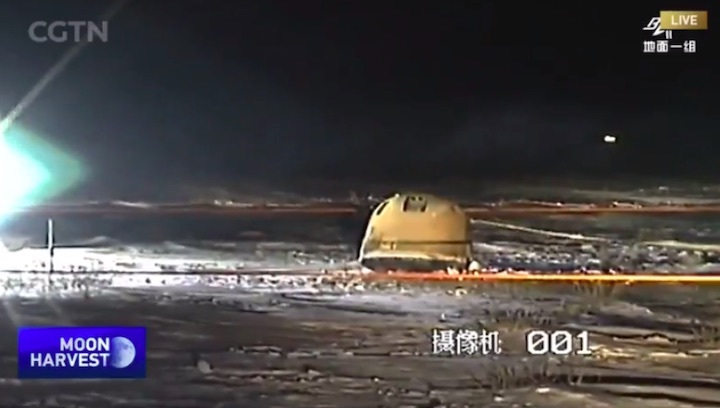
Quelle: CGTN
+++
China's Chang'e-5 lunar probe successfully returns to Earth
After weeks of space travel, Chang'e-5 lunar probe have returned to home on Thursday morning, Beijing Time.
Chang'e-5 brought back the first fresh samples of rock and debris from the moon in more than four decades.
It landed at the designated landing site in Siziwang Banner in north China's Inner Mongolia Autonomous Region.
Personnel are securing the location of China's Chang'e-5 returner and are waiting for the ground crew to arrive. The ground crew will assess the capsule and manipulate the lunar lander, eventually moving it to a secure location.
China's national flag is unfurled at the site of Chang'e-5 returner which touched down in China's Inner Mongolian region.
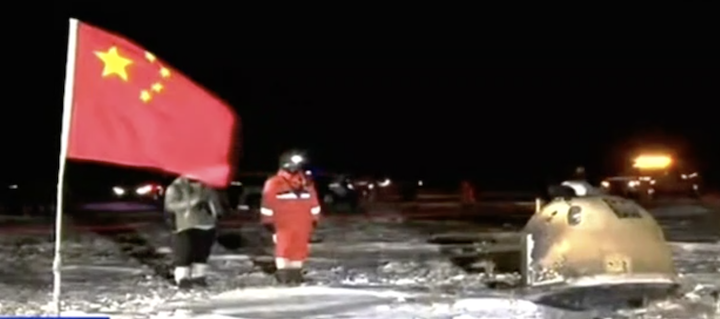
Comprising a lander, an ascender, an orbiter and a returner, the Chang'e-5 probe was launched on November 24. Its lander-ascender combination successfully landed on the near side of the moon on December 1, and collected samples from both the lunar surface and beneath.
Quelle: CGTN
----
Update: 18.12.2020
.
China lands its Moon rocks in Inner Mongolia
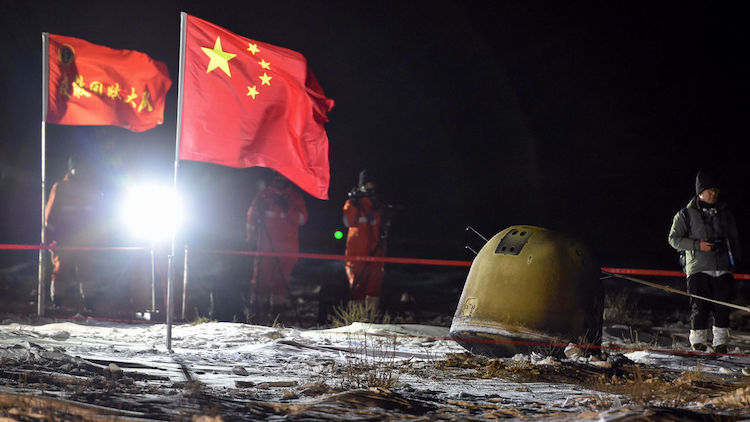
China’s Chang’e-5 mission made a triumphant return around 1 p.m. EST today, landing in the middle of the night on the dark frozen plains of Inner Mongolia, Chinese state media reported. The capsule’s return marks the first time China has collected rocks from the Moon—and the first time any nation has accomplished the feat since 1976.
The 3-week-long mission was the most complicated in the history of China’s robotic space exploration program, involving a lunar landing, furious scooping and drilling of up to 2 kilograms of grit, and then an ascent and rendezvous with an orbiter, which carried the samples back to Earth. The China National Space Administration, typically secretive with its missions, showed growing confidence in its space program, with live broadcasts of the rocket launch and return of its sample capsule, which glowed bright white from its heat in the infrared cameras that spotted it.
Chang’e-5 sampled near Mons Rümker, a 70-kilometer-wide volcanic mound on the Moon’s near side, which may have erupted as recently as about 1.3 billion years ago. Although scientists won’t know exactly how much rock the mission collected until the capsule is opened, the mission did sample what is believed to be the youngest terrain from Mons Rümker, says Long Xiao, a planetary geoscientist at the China University of Geosciences. “We are very happy with the landing site, it is where we wanted to go.”
Dating that volcanic material will help inform age estimates for the entire Solar System, and, if it is indeed young, it will raise questions about how the Moon retained so much heat for so long.
Later this week the sample capsule will be turned over to a program under the auspices of the Chinese Academy of Sciences’s National Astronomical Observatories, which has built clean room facilities with glove boxes so samples can be handled in a nitrogen environment to minimize the chance of contamination. The samples will be divided into portions for research, exhibition, and backup storage.
Chinese officials have promised to share the precious cargo internationally. One possible vehicle for doing so is through the new International Lunar and Planetary Research Center, under the Chinese Academy of Geological Sciences’s Institute of Geology. The center aims to have international groups working with lunar and other extraterrestrial samples from China and elsewhere, says Alexander Nemchin, a geologist at Curtin University and a co-chair of the group. When collaborators can jointly examine a variety of returned Moon rocks, “then you can start making progress,” he says. But under a 2011 U.S. law, NASA’s Moon rocks cannot be shared with China’s scientists, a limitation that may lead China to block U.S. access to its samples.
Quelle: Science
+++
China to encourage international cooperation on moon research
China will invite more scientists around the world to join in moon research in a bid to achieve more scientific results, according to an official from the China National Space Administration (CNSA).
China will solicit cooperation proposals extensively in accordance with regulations on the management of lunar samples and data, said Wu Yanhua, vice administrator of the CNSA, Thursday at a press conference in Bejing.
In the Chang'e-5 mission, China carried out coordination and cooperation with countries and international organizations including the European Space Agency, Argentina, Namibia and Pakistan, in space tracking and control, Wu added. Enditem
Quelle: Xinhua
+++
Commentary: China's lunar endeavor docks with world's shared space dream
n ancient Chinese mythology, the fairy lady Chang'e flew to the Moon alone, became a goddess up there, and never returned home.
On Thursday, China's lunar probe Chang'e-5 successfully touched down in north China's Inner Mongolia Autonomous Region after more than 20 days of exploration of the earth's only natural satellite some 400,000 km away, and brought home the first batch of lunar surface samples in 44 years since the Soviet Luna 24 probe in 1976.
As China has eventually completed its 16-year-long Lunar Exploration Program, part of the country's Chang'e Project, it has accomplished a raft of technological breakthroughs during the landmark space voyage.
For example, China has enabled a spacecraft to collect soil sample of the Moon automatically, lifted off from the extraterrestrial body and docked with the probe's orbiter-returner in lunar orbit before heading back to Earth.
It has been a bumper year for China's aerospace technological innovation as it also saw the completion of a nearly 30-year-long deployment of the BeiDou-3 Navigation Satellite System (BDS). The BDS is now offering free service for global users.
China's lunar adventure also marks a bold new step of the human race to get better understanding of the Moon and to decode the secrets of the outer space.
To date, countries worldwide have launched about 130 manned or unmanned missions to the Moon in total. The early exploration in the 1960s and 1970s was characterized by the space race between the United States and the former Soviet Union. The second wave of exploration started in the 21st century after scientists found in the 1990s that there might be water on the moon.
The Chang'e-5 landed in an unexplored area of the Moon called Oceanus Procellarum, or the Ocean of Storms. There, the soil and rock samples the Chinese robotic lander has retrieved are much younger than those taken by other countries in their previous lunar missions in terms of billion of years. This could help humankind solve more mysteries of lunar history.
Although the fairy tale of Chang'e has been passed down from one generation of Chinese to another for more than a millennium, China is a latecomer in space adventure.
Yet in recent years, it is catching up fast, and has become a pioneer in many aspects. This year, China has commenced its daring marching to Mars by launching its Mars probe Tianwen-1.
After many months of flying into the deep space, the probe has already travelled more than 100 million km away from Earth, and is scheduled to enter Martian orbit in February next year.
Moreover, the historic success of the Chang'e-5 mission also represents China's latest attempt to contribute to international space cooperation.
As China's Foreign Ministry Spokesperson Hua Chunying said at a recent regular press conference, China is committed to the peaceful use of the outer space and has been conducting relevant exchanges and cooperation to share aerospace progress with other countries.
After completing the rendezvous and docking mission, the ascender of Chang'e-5 landed on the Moon so that it will not become space debris that could obstruct follow-up lunar exploration probes.
China embraces openness and cooperation responsibly because it believes that outer space is not the domain of a single country and belongs to all humankind.
It is regrettable to see that some major countries are pushing forward controversial accord that allows signatories or companies to create exclusive "safety zones" on the Moon, and adopting strategies to accelerate the militarization of space. Any of such self-dealing efforts to pursue space hegemony should be firmly rejected.
Exploring mysteries of the universe has always been a shared aspiration of all humanity since ancient times when human ancestors started to gaze upon the starlit skies at night.
As the human race continues to march into the space, the Moon will be an outpost for those future adventures. And in those coming epic expeditions, China stands ready as a partner for all. Enditem
Quelle: Xinhua
+++
Commentary: China's new samples a fresh start for lunar research, space exploration
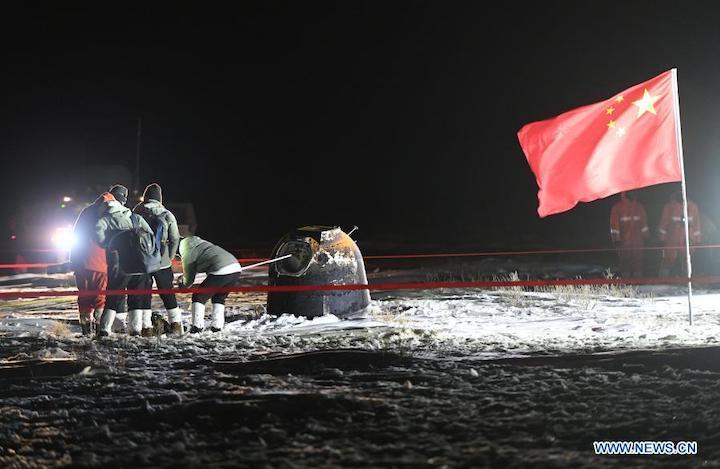
The return capsule of China's Chang'e-5 probe lands in Siziwang Banner, north China's Inner Mongolia Autonomous Region, on Dec. 17, 2020. The return capsule of China's Chang'e-5 probe touched down on Earth in the early hours of Thursday, bringing back the country's first samples collected from the moon, as well as the world's freshest lunar samples in over 40 years. (Xinhua/Lian Zhen)
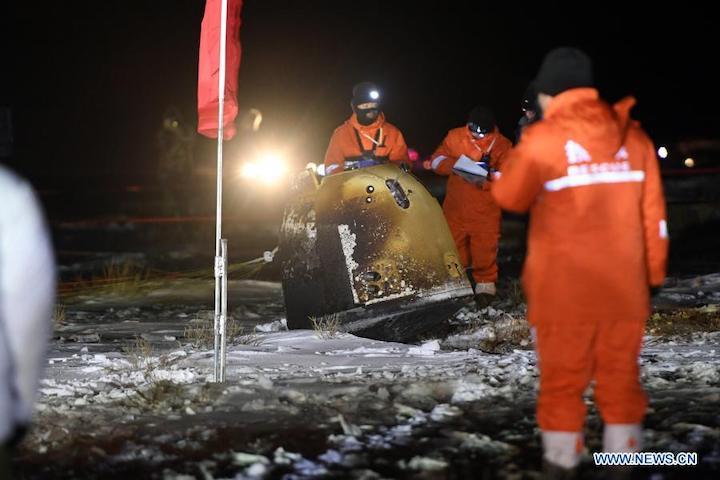
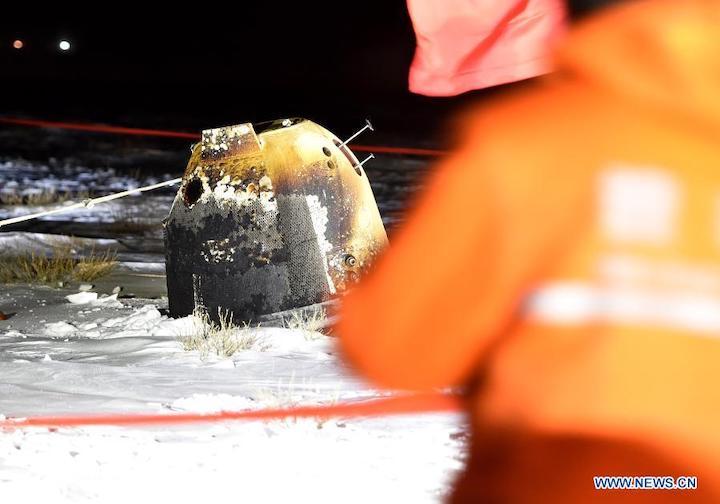
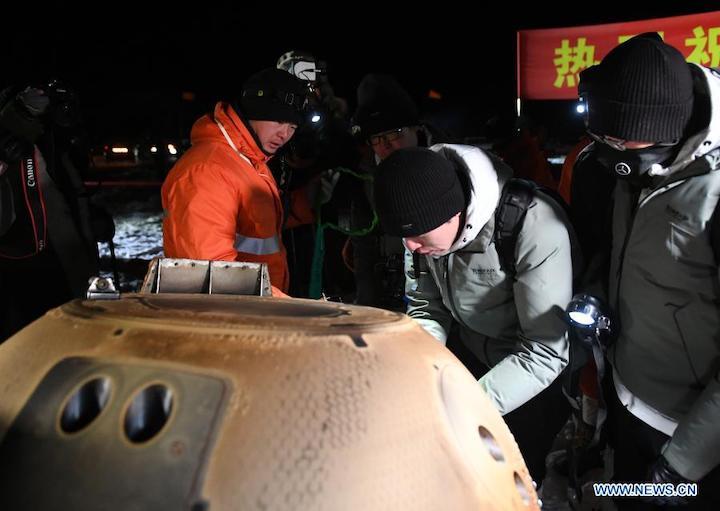
Staff members work at the landing site of the return capsule of China's Chang'e-5 probe in Siziwang Banner, north China's Inner Mongolia Autonomous Region, on Dec. 17, 2020. The return capsule of China's Chang'e-5 probe touched down on Earth in the early hours of Thursday, bringing back the country's first samples collected from the moon, as well as the world's freshest lunar samples in over 40 years. (Xinhua/Lian Zhen)
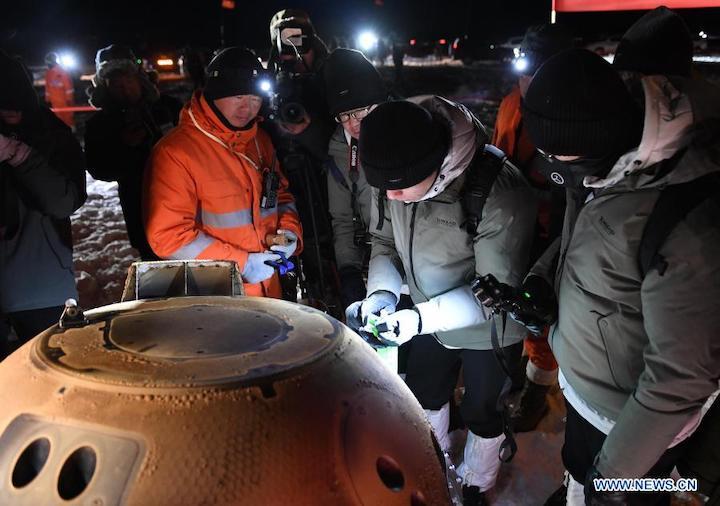
Quelle: Xinhua
+++
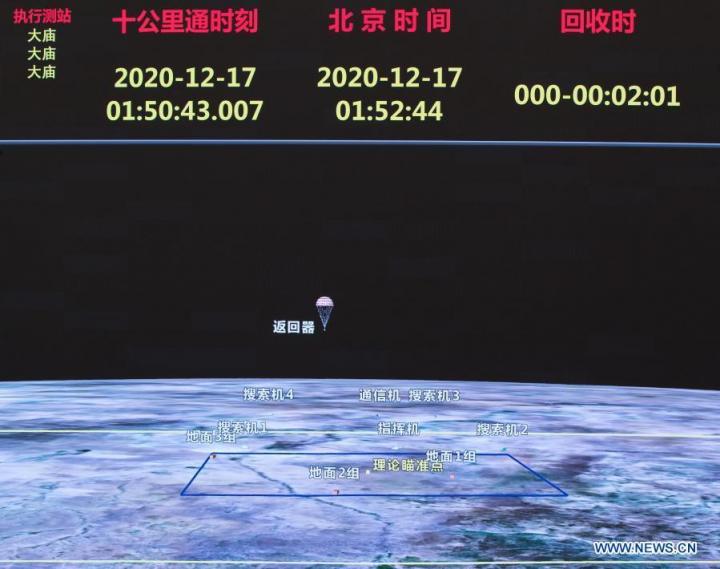
This simulated image captured at Beijing Aerospace Control Center in Beijing, capital of China, Dec. 17, 2020 shows the return capsule of China's Chang'e-5 probe landing in Siziwang Banner, north China's Inner Mongolia Autonomous Region. The return capsule of China's Chang'e-5 probe touched down on Earth in the early hours of Thursday, bringing back the country's first samples collected from the moon, as well as the world's freshest lunar samples in over 40 years. (Xinhua/Jin Liwang)
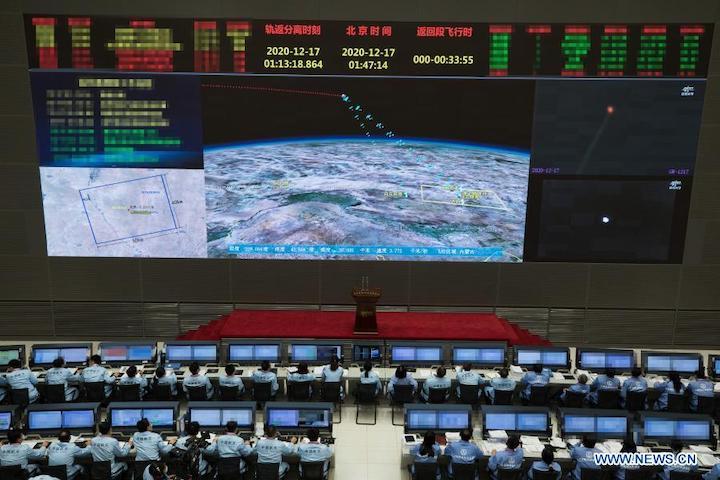
Technical personnel monitor the landing of the return capsule of China's Chang'e-5 probe at Beijing Aerospace Control Center in Beijing, capital of China, Dec. 17, 2020. The return capsule of China's Chang'e-5 probe touched down on Earth in the early hours of Thursday, bringing back the country's first samples collected from the moon, as well as the world's freshest lunar samples in over 40 years. (Xinhua/Jin Liwang)
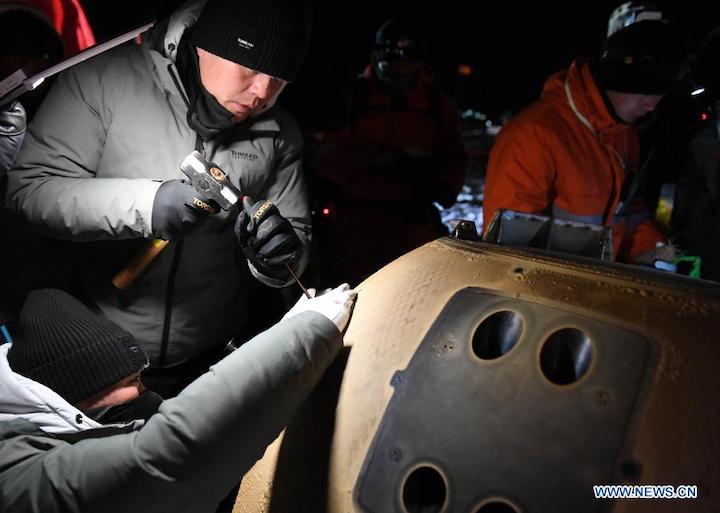
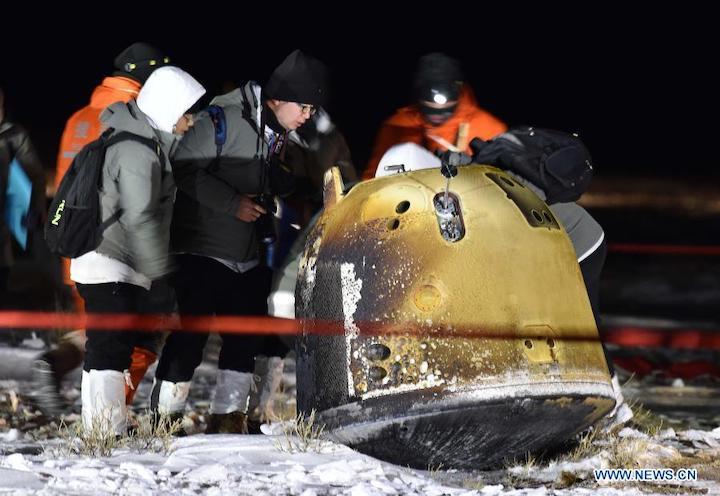
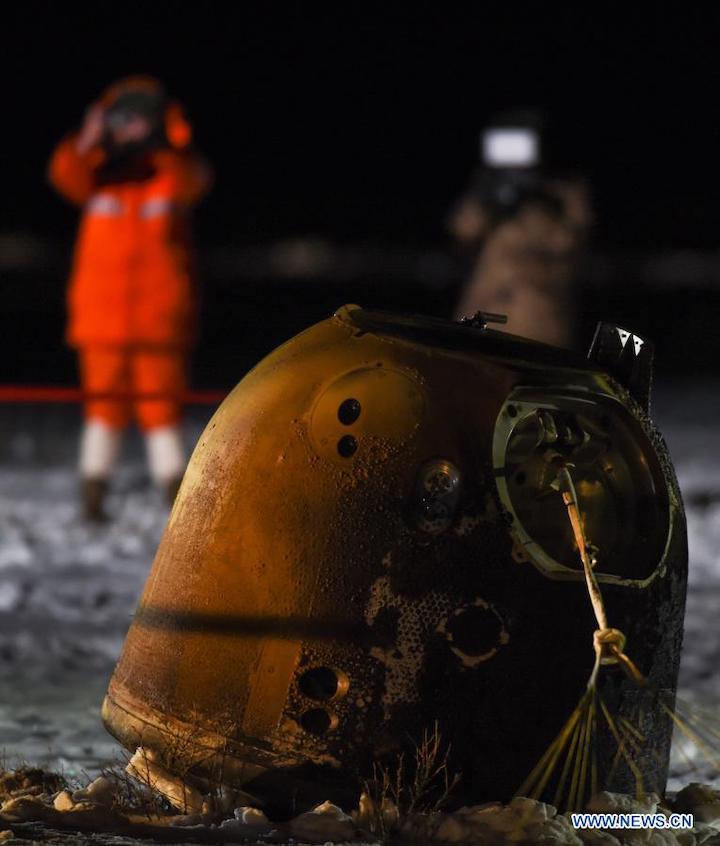
Photo taken on Dec. 17, 2020 shows the return capsule of China's Chang'e-5 probe in Siziwang Banner, north China's Inner Mongolia Autonomous Region. The return capsule of China's Chang'e-5 probe touched down on Earth in the early hours of Thursday, bringing back the country's first samples collected from the moon, as well as the world's freshest lunar samples in over 40 years. (Xinhua/Peng Yuan)
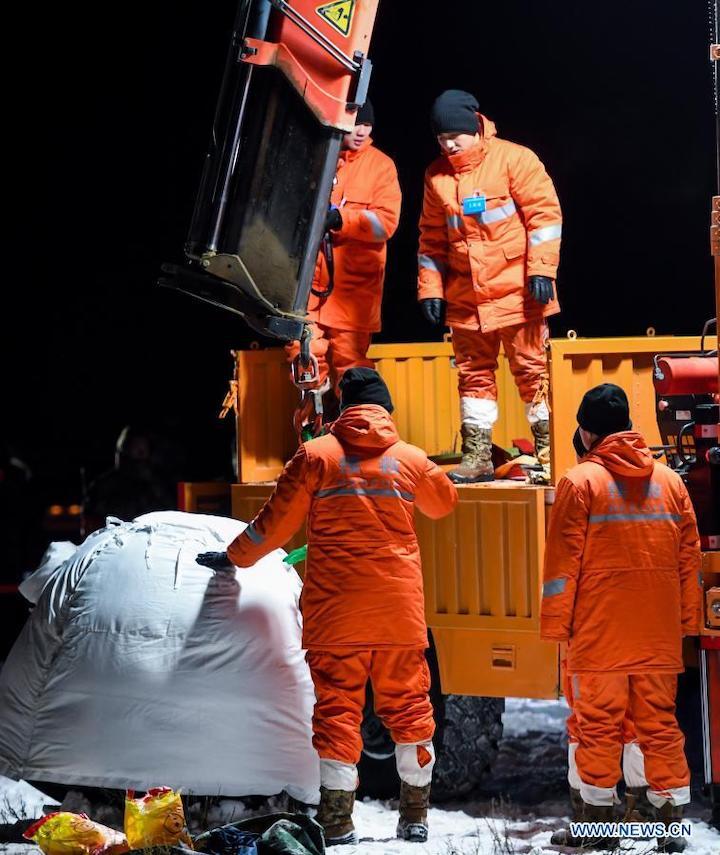
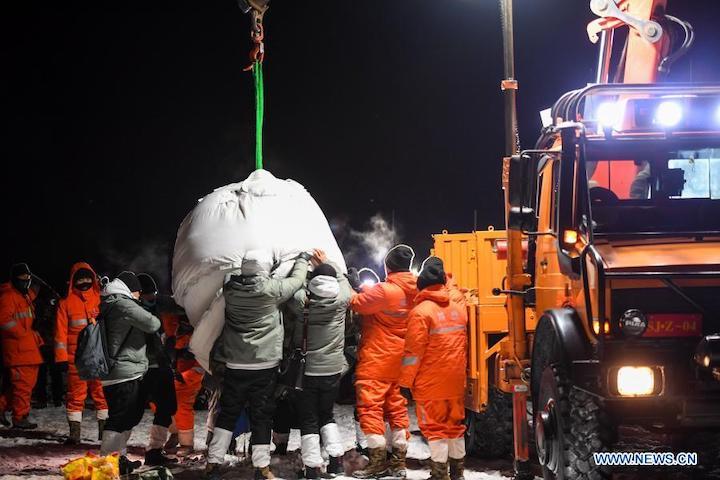
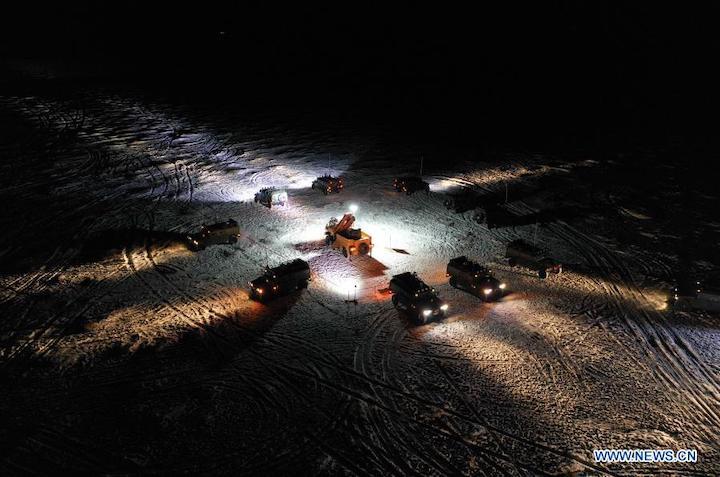
Aerial photo taken on Dec. 17, 2020 shows the retrieval site of the return capsule of China's Chang'e-5 probe in Siziwang Banner, north China's Inner Mongolia Autonomous Region. The return capsule of China's Chang'e-5 probe touched down on Earth in the early hours of Thursday, bringing back the country's first samples collected from the moon, as well as the world's freshest lunar samples in over 40 years. (Xinhua/Lian Zhen)
Quelle: Xinhua


